Level One exercise program
What is Torticollis?
Torticollis is also known as “congenital muscular torticollis.” It happens when the muscles in the neck get too tight. Some muscles get strong other muscles become weak.
- Your baby likes to tilt their head to the left (left ear to left shoulder) and turn it to the right (nose over right shoulder).
- Exercises will help stretch the tight left neck muscle and strengthen the weaker right neck muscle.
If torticollis is not corrected, your baby may have problems with their neck, body, arms, legs, vision or head shape as they grow.
How is torticollis treated?
Exercises and activities will help your baby stretch the muscles that are too tight. It will also help strengthen the weak muscles. You will learn how to do exercises and activities with your baby at home. As your baby grows and develops, you will learn new exercises and activities that will help your baby develop.
Note: It is important for you to lay your baby on their tummy several times a day while awake and supervised. This is called tummy time. By the time they are 4 months old your baby should spend a total of at least 60 to 90 minutes on their tummy per day.
Level One exercises and activities for torticollis
Do the following exercises every day. Use very gentle pressure to stretch. Do the stretches when your baby is happy and calm. If your baby resists the stretch, stop stretching and try again later.
Only do these exercises if a physical therapist has talked to you about them.
Call (414) 607-5280 with any questions or concerns.
Neck turn
- Lay your baby on their back or hold them against your chest.
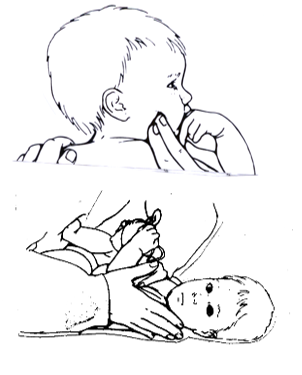
- Have your baby move their eyes and head to follow a toy or your face as far as possible to the left.
- elp your baby turn their head until your baby is looking over the left shoulder. Hold their right shoulder so it does not rise up.
- Hold this stretch for up to _____ seconds.
- Do this stretch ______ times.
- After the stretches, try to get your baby to look actively from right to left without your help.
Note: Use a gentle flat hand instead of fingertips (as shown) to help turn the head or provide pressure at the forehead. Do not press on the jaw
|
Side neck tilt
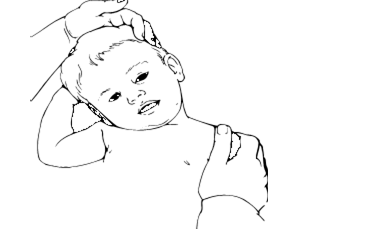 Hold your baby’s left shoulder so it does not rise up. Gently tilt your baby’s head to the right. Move the head so that the right ear moves toward the right shoulder. Make sure the left shoulder does not move when the head moves. Hold this stretch for up to _______ seconds. Do this stretch _____ times. Hold your baby’s left shoulder so it does not rise up. Gently tilt your baby’s head to the right. Move the head so that the right ear moves toward the right shoulder. Make sure the left shoulder does not move when the head moves. Hold this stretch for up to _______ seconds. Do this stretch _____ times.
|
Side tilt carrying position
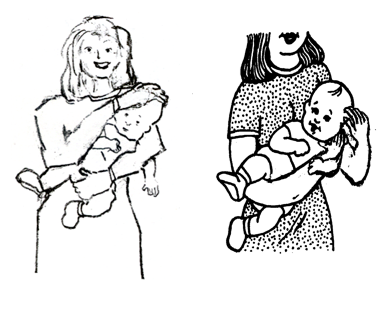 Hold your baby on their left side as your baby faces away from you. One of your arms will be between your baby’s legs. Use your other hand to gently tilt the head to the right by moving your baby’s ear towards the right shoulder. Make sure the left shoulder does not move when the head moves. Hold this stretch for up to _______ seconds. Do this stretch _____ times. You may be standing or sitting when you do this exercise. Hold your baby on their left side as your baby faces away from you. One of your arms will be between your baby’s legs. Use your other hand to gently tilt the head to the right by moving your baby’s ear towards the right shoulder. Make sure the left shoulder does not move when the head moves. Hold this stretch for up to _______ seconds. Do this stretch _____ times. You may be standing or sitting when you do this exercise.
|
Neck stretch
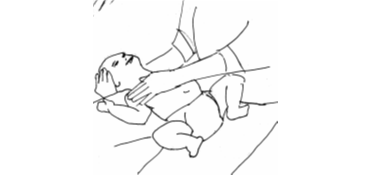 Put your child on their back over your lap. Support your child’s head with your hand. Slowly lower your child’s head, while holding their shoulders down. Use toys or a mirror to distract your child. Put your child on their back over your lap. Support your child’s head with your hand. Slowly lower your child’s head, while holding their shoulders down. Use toys or a mirror to distract your child.
|
Tummy Time
- Put your baby on their stomach. If needed, use a small blanket or towel roll to help prop your child onto their elbows.
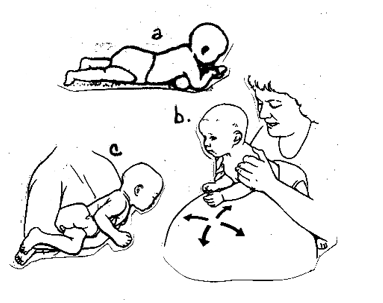
- You can work on a ball, your lap, a boppy or your chest.
- You can also carry your baby horizontally with your arms supporting their chest.
- Try to get your baby to turn and look to the left.
|
Tummy carry
- Carry your baby so that your baby is facing away from you or is on their stomach.
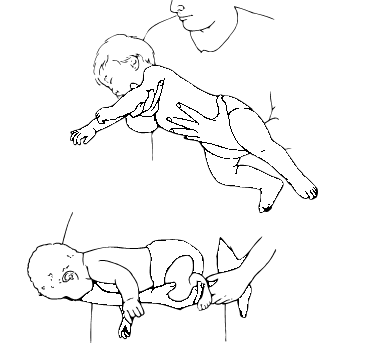
- Try to get your baby to look up while in this position. This will help make neck and back muscles stronger. Try to get your baby to reach forward with their arms.
|
Shoulder stretch
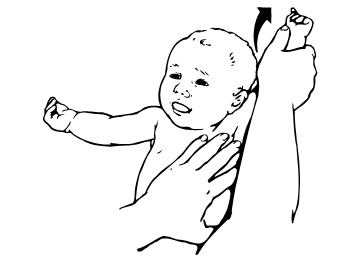 Have your baby lying on their back or in supported sitting. Gently move the _________ arm up and out toward the head with the thumb side of the hand leading the movement. Your baby’s arm should move far enough to touch their ear. Do not force the movement. Hold the stretch for seconds. Have your baby lying on their back or in supported sitting. Gently move the _________ arm up and out toward the head with the thumb side of the hand leading the movement. Your baby’s arm should move far enough to touch their ear. Do not force the movement. Hold the stretch for seconds.
|
Side bend
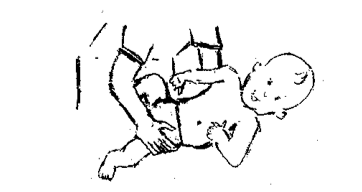 Have your baby lying on their back. Gently curve your baby’s trunk to the right so it makes a backwards “C” shape. Hold the stretch for up to _______ seconds. Do this _______ times. Have your baby lying on their back. Gently curve your baby’s trunk to the right so it makes a backwards “C” shape. Hold the stretch for up to _______ seconds. Do this _______ times.
|
Supported sitting
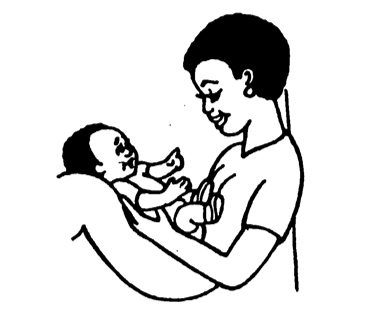 Use this position to help your baby learn to keep their head in a midline, or center, position. Try to get your baby to reach for toys and to reach for their feet while in this position. Use this position to help your baby learn to keep their head in a midline, or center, position. Try to get your baby to reach for toys and to reach for their feet while in this position.
|
Simple changes that can help your baby’s progress
- Try to get your baby to look to the left by putting the car seat or seat swing so that the activity in the room is to the left of your child.
- Have your child lay on their left side to play.
- When feeding your baby, position you and the baby to encourage head turning to the left. Your baby’s head should not be tilted when feeding.
- When holding your baby upright at your shoulder, hold them on the shoulder that makes your baby look to the left.
- When cradling your baby, you can work on positioning them with their hands and trunk in the middle.
- Use a front carrier to carry your baby.
- Limit the time spent in a bouncy chair or flat on their back and head while awake.
|
Illustrations courtesy:
Therapy Skill Builders Inc. (3830 E Bellevue, PO Box 42050, Tucson AZ 85733)
Visual Health Information (PO Box 44646, Tacoma WA 98444)
VORT Corporation (PO Box 60132, Palo Alto, CA 94306





 Hold your baby’s left shoulder so it does not rise up. Gently tilt your baby’s head to the right. Move the head so that the right ear moves toward the right shoulder. Make sure the left shoulder does not move when the head moves. Hold this stretch for up to _______ seconds. Do this stretch _____ times.
Hold your baby’s left shoulder so it does not rise up. Gently tilt your baby’s head to the right. Move the head so that the right ear moves toward the right shoulder. Make sure the left shoulder does not move when the head moves. Hold this stretch for up to _______ seconds. Do this stretch _____ times. Hold your baby on their left side as your baby faces away from you. One of your arms will be between your baby’s legs. Use your other hand to gently tilt the head to the right by moving your baby’s ear towards the right shoulder. Make sure the left shoulder does not move when the head moves. Hold this stretch for up to _______ seconds. Do this stretch _____ times. You may be standing or sitting when you do this exercise.
Hold your baby on their left side as your baby faces away from you. One of your arms will be between your baby’s legs. Use your other hand to gently tilt the head to the right by moving your baby’s ear towards the right shoulder. Make sure the left shoulder does not move when the head moves. Hold this stretch for up to _______ seconds. Do this stretch _____ times. You may be standing or sitting when you do this exercise. Put your child on their back over your lap. Support your child’s head with your hand. Slowly lower your child’s head, while holding their shoulders down. Use toys or a mirror to distract your child.
Put your child on their back over your lap. Support your child’s head with your hand. Slowly lower your child’s head, while holding their shoulders down. Use toys or a mirror to distract your child.

 Have your baby lying on their back or in supported sitting. Gently move the _________ arm up and out toward the head with the thumb side of the hand leading the movement. Your baby’s arm should move far enough to touch their ear. Do not force the movement. Hold the stretch for seconds.
Have your baby lying on their back or in supported sitting. Gently move the _________ arm up and out toward the head with the thumb side of the hand leading the movement. Your baby’s arm should move far enough to touch their ear. Do not force the movement. Hold the stretch for seconds. Have your baby lying on their back. Gently curve your baby’s trunk to the right so it makes a backwards “C” shape. Hold the stretch for up to _______ seconds. Do this _______ times.
Have your baby lying on their back. Gently curve your baby’s trunk to the right so it makes a backwards “C” shape. Hold the stretch for up to _______ seconds. Do this _______ times. Use this position to help your baby learn to keep their head in a midline, or center, position. Try to get your baby to reach for toys and to reach for their feet while in this position.
Use this position to help your baby learn to keep their head in a midline, or center, position. Try to get your baby to reach for toys and to reach for their feet while in this position.